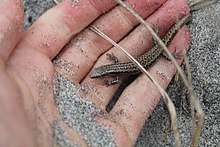Shore skink
The shore skink (Oligosoma smithi),[2] also commonly known as the short-tailed skink,[2] Smith's ground skink,[3] Smith's moco,[4] and Smith's skink,[2] is a species of lizard in the family Scincidae. The species is native to the northern half of the North Island of New Zealand.
| Shore skink | |
|---|---|
 | |
| Scientific classification | |
| Kingdom: | Animalia |
| Phylum: | Chordata |
| Class: | Reptilia |
| Order: | Squamata |
| Family: | Scincidae |
| Genus: | Oligosoma |
| Species: | O. smithi |
| Binomial name | |
| Oligosoma smithi (Gray, 1845) | |
| Synonyms[1] | |
| |
Habitat
The shore skink is always found near the shoreline and prefers open areas such as around driftwood at the high tide mark.[2]
Diet
Oligosoma smithi eats insects and probably anything that moves and fits in its mouth.
Behavior
The shore skink is diurnal (active during the day) and spends most of its time hunting or basking in the sun.
Description
O. smithi is small species of skink, growing to a snout-to-vent length (SVL) of 8 cm (3.1 in). It is well camouflaged, and may be found in a range of colours, sometimes almost black. Like most New Zealand skinks, it is viviparous (reproduces by giving birth to live young).
Conservation status
As of 2012 the Department of Conservation (DOC) classified the shore skink as Not Threatened under the New Zealand Threat Classification System.[5]
Etymology
The specific name, smithi, is in honor of British naval officer Lt Alexander Smith who collected the original specimens in the 1840s, and presented them to his uncle John Edward Gray, who described the new species.[3]
References
- "Oligosoma smithi ". The Reptile Database. www.reptile-database.org.
- "Shore Skink". Hamilton Zoo. Hamilton Zoo. Retrieved 13 December 2015.
- Beolens, Bo; Watkins, Michael; Grayson, Michael (2011). The Eponym Dictionary of Reptiles. Baltimore: Johns Hopkins University Press. xiii + 296 pp. ISBN 978-1-4214-0135-5. (Oligosoma smithi, p. 246).
- Gray, 1845.
- Hitchmough, Rod; Anderson, Peter; Barr, Ben; Monks, Jo; Lettink, Marieke; Reardon, James; Tocher, Mandy; Whitaker, Tony. "Conservation status of New Zealand reptiles, 2012" (PDF). Department of Conservation. New Zealand Government. Retrieved 18 July 2015.
Further reading
- Boulenger GA (1887). Catalogue of the Lizards in the British Museum (Natural History). Second Edition. Volume III. ... Scincidæ ... London: Trustees of the British Museum (Natural History). (Taylor and Francis, printers). xii + 575 pp. + Plates I-XL. (Lygosoma smithii, pp. 274–275).
- Gray JE (1845). Catalogue of the Specimens of Lizards in the Collection of the British Museum. London: Trustees of the British Museum. (Edward Newman, printer). xxviii + 289 pp. (Mocoa smithii, new species, pp. 82–83).